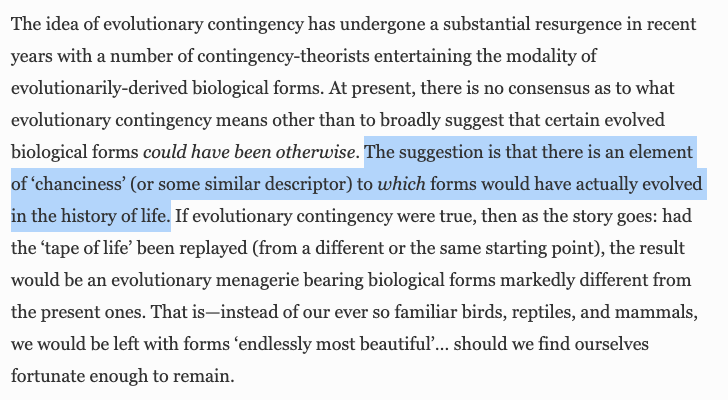Bad takes #5. It’s just contingency
Unfamiliar ideas are often mis-identified and mis-characterized. It takes time for a new idea to be sufficiently familiar that it can be debated meaningfully. We look forward to those more meaningful debates. Until then, fending off bad takes is the order of the day! See the Bad Takes Index.
A common “stages of truth” meme holds that successful disruptive ideas are first (1) dismissed as absurd, then (2) resisted— the idea is declared unlikely and the evidence is strenuously disputed—, and finally (3) regarded as trivial and attributed to long tradition. Haldane’s version is that “The process of acceptance will pass through the usual four stages: (i) this is worthless nonsense; (ii) this is an interesting, but perverse, point of view; (iii) this is true, but quite unimportant; (iv) I always said so.” The QuoteInvestigator piece on the stages-of-truth meme has this version:
For it is ever so with any great truth. It must first be opposed, then ridiculed, after a while accepted, and then comes the time to prove that it is not new, and that the credit of it belongs to some one else
Svensson and Berger (2019)— in an article that reads like a Sokal’s hoax of Bad Synthesis Apologetics— model all the stages of truth in the same paper: (1) they dismiss strawman versions (e.g., mutation as an independent cause of adaptation) as absurd (see Bad Takes #3 and Bad Takes #4), (2) they present a clumsy version of the theory but dispute the evidence and declare it implausible based on a list of fake theoretical restrictions, and (3) finally, implicitly admitting that the phenomenon is real and that the theory we proposed is correct, they describe it as trivial and familiar:
These studies therefore only exemplify how historical contingency and mutational history interact with selection during adaptation to novel environments [31, 38, 52], entirely in line with standard evolutionary theory and the uncontroversial insight that different genomic regions contribute differentially to adaptation driven by selection, with mutations merely providing the genetic input [53].
In this way, the reader is guided through the stages of truth from patent absurdity to yesterday’s news.
However, our focus here is only on the end-point of this progression, in which Svensson and Berger (2019) give the impression that the new work on mutation-biased adaptation represents ordinary textbook knowledge, so that these new results induce no changes in evolutionary reasoning, raise no new questions, and suggest no new priorities for research. The specific implication of the passage above is that these findings are merely a matter of “contingency” and present nothing original or new relative to the contents of references 31, 38 and 52.

Yet contingency is not a causal theory: it is an explanatory concept indicating that a system is non-equilibrium, so that the state of the system cannot be predicted without knowing the initial conditions and detailed dynamics. The notion of contingency, by itself, does not provide a theory of the dynamics. If we try to answer the odd question, “what does contingency predict about how the mutation spectrum shapes the spectrum of adaptive substitutions?” then we will get nowhere without a theory for the dynamics, and this theory will have no need for a concept of contingency (an explanatory concept, not a cause of anything), but will directly addresses how the details of mutation rates influence the spectrum of adaptive substitutions.
Svensson and Berger have a bad habit of misrepresenting cited works. What do refs 31, 38 and 52 say? References 31 and 38 are from the field of quantitative genetics, and simply do not provide any such dynamical theory, e.g., here is the abstract to reference 31:
The introduction and rapid spread of Drosophila subobscura in the New World two decades ago provide an opportunity to determine the predictability and rate of evolution of a geographic cline. In ancestral Old World populations, wing length increases clinally with latitude. In North American populations, no wing length cline was detected one decade after the introduction. After two decades, however, a cline has evolved and largely converged on the ancestral cline. The rate of morphological evolution on a continental scale is very fast, relative even to rates measured within local populations. Nevertheless, different wing sections dominate the New versus Old World clines. Thus, the evolution of geographic variation in wing length has been predictable, but the means by which the cline is achieved is contingent.
Reference 52 is Good, et al (2017), a deep sequencing study of samples from Lenski’s LTEE (long-term evolution experiment). This is mainly an empirical analysis of allele trajectories and clonal interference and so on. There are no explicit claims for an effect of mutation bias on the spectrum of adaptive substitutions (mutation bias is mentioned only in relation to mutators, but mutators generate a lot of hitch-hikers in this experiment, so that the influence of mutators on the set of adaptive changes is not clearly established). Indeed, the presentation of results indicates in various places (e.g., the comments on parallelism) that Good et al are not paying attention to the issue of how mutation bias influences probabilities of beneficial changes.
What is going on here? Svensson and Berger (2019) seem intent on illustrating how to avoid addressing the novelty of (1) a formal pop-gen theory that focuses on the introduction process, and which makes novel predictions about evolution based on tendencies of variation (addressing aspects of parallelism, trends, GP maps, findability, etc), in a way that directly contradicts the classic Haldane-Fisher “mutation pressure” argument, and (2) empirical results confirming a distinctive prediction of this theory, namely effects of mutation biases on adaptation (not requiring neutrality or high mutation rates), contradicting a long neo-Darwinian tradition of dismissing internal biases in evolution.
One way to avoid these key issues is to engage in whataboutery, i.e., responding to an issue by demanding attention to a second issue. What about other research? What about selection? Whataboutery provides the writer an opportunity to engage the reader on some related topic, e.g., for purposes of name-dropping. Rather than taking the opportunity to educate readers on the details of a new and exciting — but poorly known — body of work on mutation bias and molecular adaptation, i.e., the ostensible topic of their commentary, Svensson and Berger instead lavish their attention on older and much better known work on related topics by eminent scientists, e.g., the LTEE from Lenski and colleagues, lizard stuff from Jonathan Losos, the famous stickleback Pitx1 example, or David Houle’s work on fly wings.
More generally, Svensson and Berger (2019) illustrate how Synthesis apologists do not contemplate the practice of science in terms of falsifiable theories, precise reasoning, or the prospect of striking future discoveries, but are mainly concerned with crafting a narrative of tradition that integrates important people and flexible themes. They trivialize new work by assigning it to familiar and vague categories that make it seem ordinary, rather than mapping it to the specific issues that motivate it, make it significant, and raise unanswered questions for the future.

To understand how this game works, consider a completely unrelated example, namely the invention of a telephone 150 years ago (image). The novelty-hating curmudgeon may object as follows: You say there is something new here? How arrogant to make such a claim! There is nothing new here at all! This is merely an engineered device, and inventors have been crafting devices for centuries! I could show you 15 devices from just the past few years that are more impressive than this one, with more parts. You have done nothing to acknowledge this past work. Have you no respect? There is no fundamentally new technology here, merely pieces of wood and metal and wire! I could build something like this in an afternoon for $25. There are no new electrical or mechanical principles at work, merely electrical currents and vibrations controlled by magnets. It looks like other devices I have seen. I could break it easily with a hammer. I doubt that it can fly like an airplane.
The problem is not that these objections are false statements. They could all be true. The problem is that they fail to address the crucial issue: the telephone prototype instantiates a generalizable technology to support remote voice communication through wires, thus over long distances.
Svensson and Berger have done an excellent job of illustrating how to play the irrelevant-objections-to-novelty game. When they argue that new work on mutation-biased adaptation is just another example of contingency, this represents the strategy of describing new work in a trivially general way, like saying that the first telephone is just a device. When they claim that the theory we proposed is already part of the Modern Synthesis, on the grounds that it can be broken down into familiar parts, this is like objecting that the telephone is made of familiar parts and therefore does not represent something new but is merely part of a familiar tradition of constructing devices.
Of course, the significance of a new device— or a new theory— is not in the list of parts, but in what the assembled whole accomplishes.
What is the actual significance of recent work on mutation-biased adaptation? The essence of neo-Darwinism is a dichotomy of variation and selection, in which variation merely provides raw materials (substance, not form), and selection is the source of order, shape, and direction. Theories of evolution subject to internal biases directly contradict neo-Darwinism and were considered heretical. The argument of Haldane and Fisher that such theories are incompatible with population genetics (see Bad takes #2) was eagerly adopted by the architects of modern neo-Darwinism, yet (1) this classic conclusion is unwarranted theoretically and (2) its implications are refuted empirically. These two provocative claims are established by recent work on mutation-biased adaptation; they are not part of textbook knowledge; they are not established in well known studies cited by Svensson and Berger to illustrate scientific name-dropping.